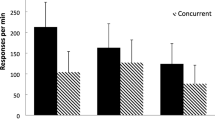Abstract
Fluency is a metaphor for flowing, effortless, well-practiced, and accurate performance. Current practice in fluency building involves increasing the frequency of free-operant performances. Free-operant performance is defined as continuous responding in the presence of discriminative stimuli that are either varied or not varied from response to response. Free-operant performance is also distinguished from discrete-trial performance. Frequency-building procedures are also described, including defining the learning channel and stimulus control topography of a component performance (called a pinpoint), selecting an appropriate timing period, and displaying stimuli so that no performance ceilings occur. During frequency building, frequencies of pinpoints are continuously charted on standard celeration charts. Frequencies are increased to empirically derived performance standards, or aims, that predict retention, endurance, stability, application, and adduction of performance. Frequency is also described as a dimension of performance, not simply its measurement. Frequency building is described as possibly facilitating contingency adduction.
Similar content being viewed by others
References
Andronis, P. T. (1983). Symbolic aggression by pigeons: Contingency coadduction. Unpublished doctoral dissertation, University of Chicago.
Barrett, B. H. (1977). Behavior analysis. In J. Wortis (Ed.), Mental retardation and developmental disabilities, (Vol. 9, pp. 141–202). New York: Bruner/Mazel.
Binder, C. (1988). Precision teaching: Measuring and attaining exemplary academic achievement. Youth Policy, 10, 12–15.
Binder, C. (1993). Behavioral fluency: A new paradigm. Educational Technology, 44, 8–14.
Dempster, F. N. (1988). The spacing effect: A case study in the failure to apply the results of psychological research. American Psychologist, 43, 627–634.
Donahoe, J. W., & Palmer, D. (1994). Learning and complex behavior. Needham Heights, MA: Allyn and Bacon.
Ferster, C. B. (1953). The use of the free operant in the analysis of behavior. Psychological Bulletin, 50, 263–274.
Ferster, C. B., Culbertson, S., & Boren, M. C. P. (1975). Behavior principles. Englewood Cliffs, NJ: Prentice Hall.
Gagne, R. M. (1970). The conditions of learning (2nd ed.). New York: Holt, Rinehart & Winston.
Haughton, E. C. (1972). Aims: Growing and sharing. In J. B. Jordan & L. S. Robbins (Eds.), Let’s try doing something else kind of thing (pp. 20–39). Arlington, VA: Council for Exceptional Children.
Haughton, E. C. (1980). Practicing practices: Learning by activity. Journal of Precision Teaching, 1, 3–20.
Johnson, K. R., & Layng, T. V. J. (1992). Breaking the structuralist barrier: Literacy and numeracy with fluency. American Psychologist, 47, 1475–1490.
Johnson, K. R., & Layng, T. V. J. (1994). The Morningside model of generative instruction. In R. Gardner, D. Sainato, J. Cooper, T. Heron, W. Heward, J. Eshleman, & T. Grossi (Eds.), Behavior analysis in education: Focus on measurably superior instruction (pp. 173–197). Belmont, CA: Brooks-Cole.
Layng, T. V. J., & Andronis, P. T. (1984). Toward a functional analysis of delusional speech and hallucinatory behavior. The Behavior Analyst, 7, 139–156.
Lindsley, O. (1964). Direct measurement and prosthesis of retarded behavior. Journal of Education, 147, 62–81.
Lindsley, O. (1972). From Skinner to precision teaching: The child knows best. In J. B. Jordan & L. S. Robbins (Eds.), Let’s try doing something else kind of thing (pp. 1–11). Arlington, VA: Council for Exceptional Children.
Resnick, L. B., Wang, M. C., & Kaplan, J. (1973). Task analysis in curriculum design: A hierarchically sequenced introductory mathematics curriculum. Journal of Applied Behavior Analysis, 6, 679–710.
Tiemann, P. W., & Markle, S. M. (1990). Analyzing instructional content: A guide to instruction and evaluation. Champaign, IL: Stipes.
White, O. R., & Haring, N. G. (1976). Exceptional teaching. Columbus, OH: Charles E. Merrill.
Author information
Authors and Affiliations
Rights and permissions
About this article
Cite this article
Johnson, K.R., Layng, T.V.J. On Terms and Procedures: Fluency. BEHAV ANALYST 19, 281–288 (1996). https://doi.org/10.1007/BF03393170
Published:
Issue Date:
DOI: https://doi.org/10.1007/BF03393170




